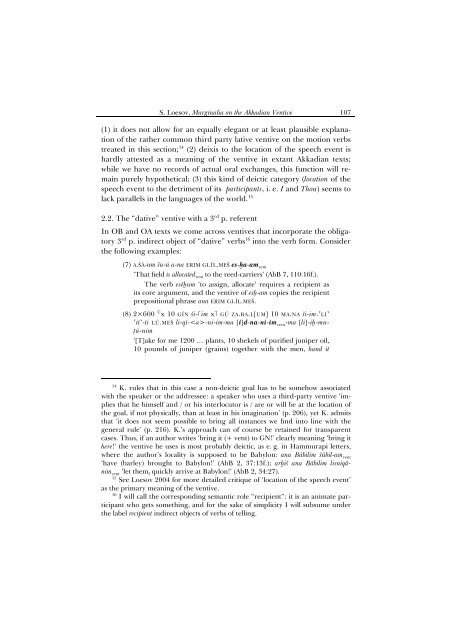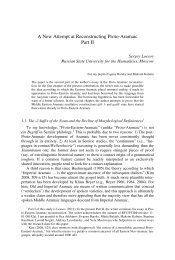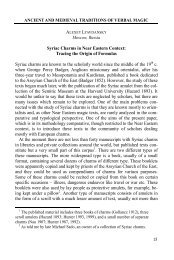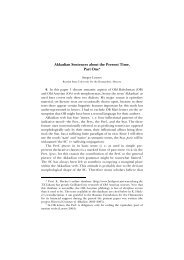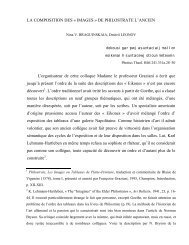Marginalia on the Akkadian Ventive*
Marginalia on the Akkadian Ventive*
Marginalia on the Akkadian Ventive*
Create successful ePaper yourself
Turn your PDF publications into a flip-book with our unique Google optimized e-Paper software.
S. Loesov, <str<strong>on</strong>g>Marginalia</str<strong>on</strong>g> <strong>on</strong> <strong>the</strong> <strong>Akkadian</strong> Ventive 107<br />
(1) it does not allow for an equally elegant or at least plausible explanati<strong>on</strong><br />
of <strong>the</strong> ra<strong>the</strong>r comm<strong>on</strong> third party lative ventive <strong>on</strong> <strong>the</strong> moti<strong>on</strong> verbs<br />
treated in this secti<strong>on</strong>; 14 (2) deixis to <strong>the</strong> locati<strong>on</strong> of <strong>the</strong> speech event is<br />
hardly attested as a meaning of <strong>the</strong> ventive in extant <strong>Akkadian</strong> texts;<br />
while we have no records of actual oral exchanges, this functi<strong>on</strong> will remain<br />
purely hypo<strong>the</strong>tical; (3) this kind of deictic category (locati<strong>on</strong> of <strong>the</strong><br />
speech event to <strong>the</strong> detriment of its participants, i. e. I and Thou) seems to<br />
lack parallels in <strong>the</strong> languages of <strong>the</strong> world. 15<br />
2.2. The “dative” ventive with a 3 rd p. referent<br />
In OB and OA texts we come across ventives that incorporate <strong>the</strong> obligatory<br />
3 rd p. indirect object of “dative” verbs 16 into <strong>the</strong> verb form. C<strong>on</strong>sider<br />
<strong>the</strong> following examples:<br />
(7) A.ŠÀ-um šu-ú a-na ERIM GI.ÍL.MEŠ es-a-am vent<br />
‘That field is allocated vent to <strong>the</strong> reed-carriers’ (AbB 7, 110:16f.).<br />
The verb esēum ‘to assign, allocate’ requires a recipient as<br />
its core argument, and <strong>the</strong> ventive of es-am copies <strong>the</strong> recipient<br />
prepositi<strong>on</strong>al phrase ana ERIM GI.ÍL.MEŠ.<br />
(8) 2×600 Ú x 10 GÍN ši-⌈im x⌉ GÚ ZA.BA.L[UM] 10 MA.NA ši-im.<br />
-ti LÚ.MEŠ li-qí--ni-im-ma [i]d-na-ni-im vent-ma [li]-i-mu-<br />
¢ú-nim<br />
‘[T]ake for me 1200 … plants, 10 shekels of purified juniper oil,<br />
10 pounds of juniper (grains) toge<strong>the</strong>r with <strong>the</strong> men, hand it<br />
14 K. rules that in this case a n<strong>on</strong>-deictic goal has to be somehow associated<br />
with <strong>the</strong> speaker or <strong>the</strong> addressee: a speaker who uses a third-party ventive ‘implies<br />
that he himself and / or his interlocutor is / are or will be at <strong>the</strong> locati<strong>on</strong> of<br />
<strong>the</strong> goal, if not physically, than at least in his imaginati<strong>on</strong>’ (p. 206), yet K. admits<br />
that ‘it does not seem possible to bring all instances we find into line with <strong>the</strong><br />
general rule’ (p. 216). K.’s approach can of course be retained for transparent<br />
cases. Thus, if an author writes ‘bring it (+ vent) to GN!’ clearly meaning ‘bring it<br />
here!’ <strong>the</strong> ventive he uses is most probably deictic, as e. g. in Hammurapi letters,<br />
where <strong>the</strong> author’s locality is supposed to be Babyl<strong>on</strong>: ana Bābilim šūbil-amvent ‘have (barley) brought to Babyl<strong>on</strong>!’ (AbB 2, 37:13f.); ariš ana Bābilim lisniqānimvent<br />
‘let <strong>the</strong>mf quickly arrive at Babyl<strong>on</strong>!’ (AbB 2, 34:27).<br />
15 See Loesov 2004 for more detailed critique of ‘locati<strong>on</strong> of <strong>the</strong> speech event’<br />
as <strong>the</strong> primary meaning of <strong>the</strong> ventive.<br />
16 I will call <strong>the</strong> corresp<strong>on</strong>ding semantic role “recipient”: it is an animate participant<br />
who gets something, and for <strong>the</strong> sake of simplicity I will subsume under<br />
<strong>the</strong> label recipient indirect objects of verbs of telling.


